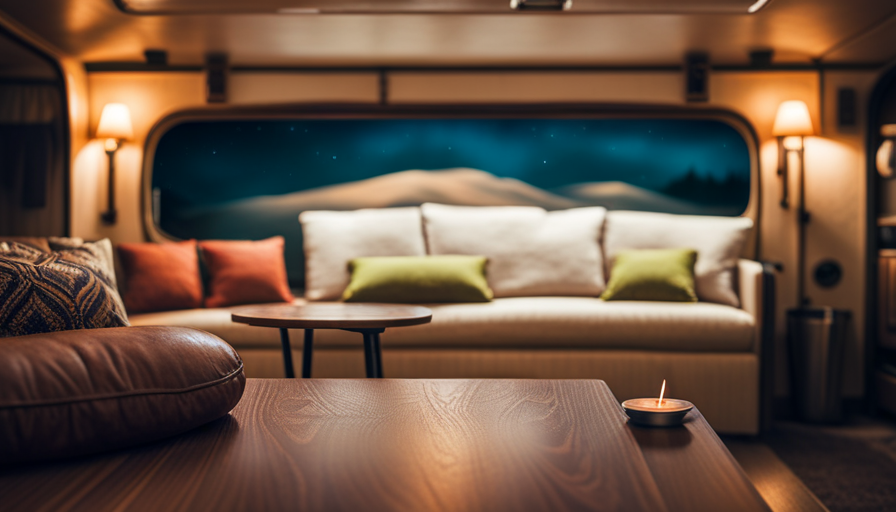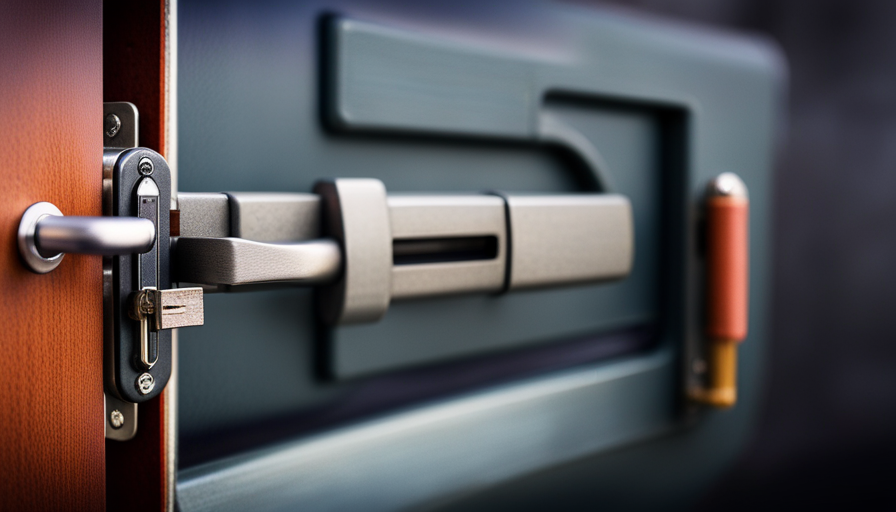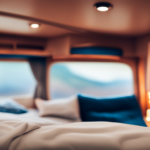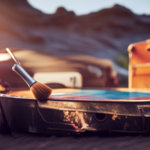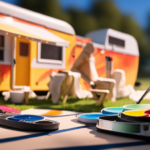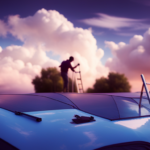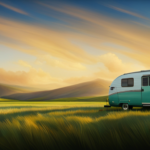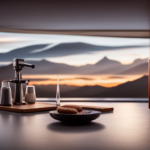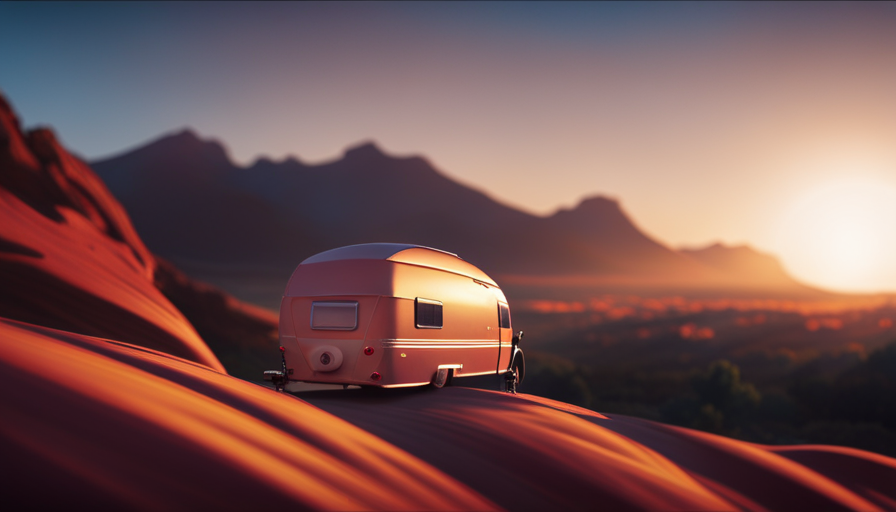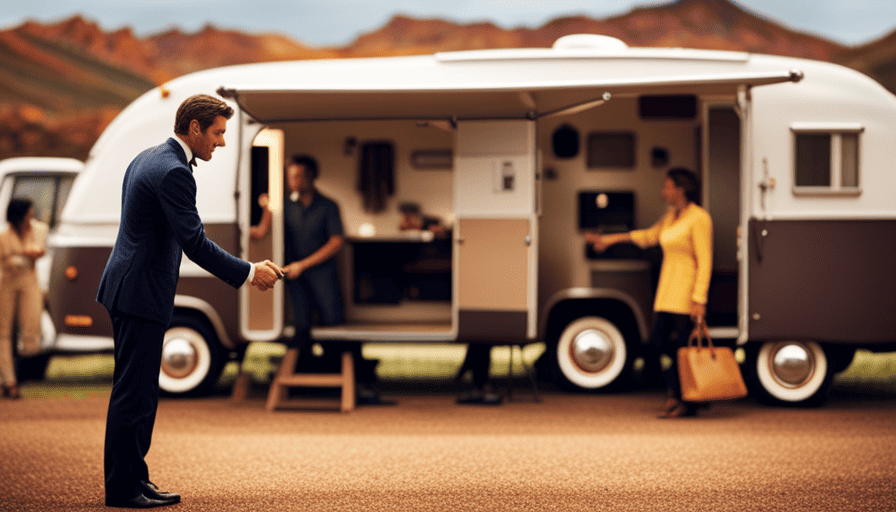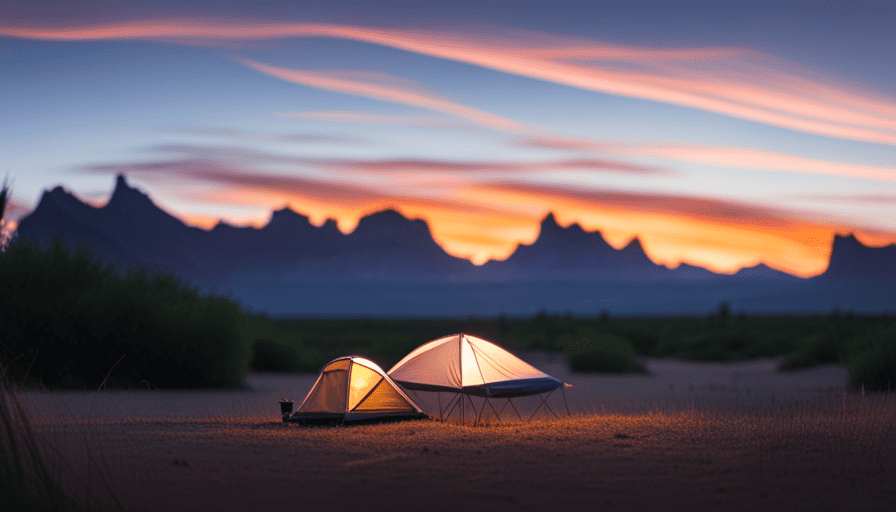If you have a camper and you’re eager to update its interior, you’ve landed in the perfect spot!
In this step-by-step guide, I’ll show you how to paint your camper’s interior like a pro. From assessing the condition of your camper to selecting the perfect color scheme, gathering supplies, and preparing the surfaces, we’ll cover it all.
With a roller or brush in hand, we’ll dive into the painting process, making sure to protect surfaces with tape and drop cloths. Applying multiple coats and allowing sufficient drying time will ensure a professional finish that you can enjoy for years to come.
So, grab your paintbrush and let’s get started on transforming your camper’s interior into a space that reflects your personal style and makes you feel right at home.
Key Takeaways
- Assess the condition of the camper’s interior before starting the painting process.
- Choose a color palette and plan a color scheme that suits your preferences and the overall style of the camper.
- Gather all the necessary supplies and ensure proper ventilation in the painting area.
- Properly prepare the surfaces by cleaning them and applying a primer before painting to ensure a smooth and long-lasting finish.
Assess the Condition of Your Camper’s Interior
Take a good look inside your camper and see just how much potential awaits you! The first step in painting your camper’s interior is to assess the condition of the space. Start by evaluating any damage or wear and tear that may need to be addressed before painting. Look for any holes, cracks, or water damage that may require repairs. Patch up any imperfections and make sure the walls are clean and smooth.
Once you’ve assessed the condition of the interior, it’s time to select a color palette. Consider the overall aesthetic you want to achieve and choose colors that’ll complement your style. Keep in mind that lighter colors can make a small space appear larger, while darker colors can create a cozy and intimate atmosphere. Take into account the natural lighting inside your camper and how the colors will interact with it.
Planning your color scheme and design is crucial for achieving the desired look and feel in your camper. Think about the mood you want to create and how the colors will contribute to that ambiance. Whether you prefer a modern, rustic, or bohemian style, your color palette will play a significant role.
So, let’s move on to the next step and start planning your color scheme and design.
Plan Your Color Scheme and Design
Start by envisioning the perfect color palette and layout that’ll transform your camper into a cozy and inviting retreat. Choosing the right color scheme is essential to creating the desired atmosphere.
Consider the size of your camper and the amount of natural light it receives when selecting colors. Lighter shades can make small spaces appear larger, while darker tones can add warmth and depth. Look for interior design inspiration online or in magazines to help you visualize different possibilities.
Once you have an idea of the colors you want to incorporate, think about how you want to arrange the space. Consider the placement of furniture, storage solutions, and any decorative elements you want to include. Make sure to create a layout that maximizes functionality and makes the most of the available space.
Now that you have a clear vision of your color scheme and design, it’s time to gather the necessary supplies and tools to bring your plan to life. Without further ado, let’s move on to the next section about gathering the necessary supplies and tools.
Gather the Necessary Supplies and Tools
Get ready to dive into your project by gathering all the essential supplies and tools, like a painter with their trusty brush and palette, to bring your vision to life. Before you start painting your camper interior, it’s important to choose the right colors that will create the desired atmosphere. Consider the size of your camper and the amount of natural light it receives to determine whether light or dark colors will work best. Once you have chosen your colors, it’s time to gather the necessary supplies. Here is a handy table to help you keep track:
| Supplies | Tools |
|---|---|
| Paint brushes | Paint roller |
| Paint rollers | Paint tray |
| Paint trays | Drop cloths |
| Primer | Sandpaper |
| Masking tape | Painter’s tape |
Ensuring proper ventilation is crucial when painting the interior of a camper. Open all windows and doors to allow fresh air to circulate. If necessary, use fans to improve airflow. Now that you have gathered your supplies and tools, and created a well-ventilated space, you are ready to prepare the surfaces for painting.
Prepare the Surfaces for Painting
Ensure that the surfaces are smooth and clean, creating a blank canvas ready for your creative transformation. To properly prepare the surfaces for painting your camper interior, follow these steps:
-
Start by removing any loose or peeling paint using a scraper or sandpaper. This will ensure that the new paint adheres well to the surface.
-
Next, use a sanding block or sandpaper to smooth out any rough spots or imperfections on the walls and cabinets. Be sure to sand in the direction of the grain to avoid damaging the surface.
-
Once the surfaces are smooth, wipe them down with a damp cloth to remove any dust or debris. This will ensure that the paint goes on smoothly and evenly.
By taking the time to properly prepare the surfaces, you’ll ensure that your paint job looks professional and lasts for years to come. Now that the surfaces are ready, it’s time to apply primer to ensure proper adhesion.
Apply Primer to Ensure Proper Adhesion
Once the surfaces have been properly prepared, it’s time to seal the deal with a layer of primer to ensure flawless adhesion for your transformation.
Choosing the right paint color is an important step in giving your camper interior a fresh new look. Consider the overall theme you want to achieve and select a color that complements it. Whether you prefer a neutral tone for a clean and modern feel, or a bold and vibrant color for a more lively atmosphere, the choice is yours.
Proper application techniques are crucial to achieving a professional finish. Start by using a brush or roller to apply the primer evenly across the surfaces. Make sure to cover all areas, including corners and edges. Allow the primer to dry completely before moving on to the next step. This will create a smooth and even surface for the topcoat.
Transitioning into the subsequent section about choosing the right paint for your camper’s interior, it’s important to consider the type of paint that will work best for your project. Different paints have different finishes and durability levels, so take the time to research and select the right one for your needs.
Choose the Right Paint for Your Camper’s Interior
To achieve a polished and refined look inside your camper, it’s essential to carefully select the ideal paint that perfectly complements your desired aesthetic. When choosing the right paint finish for your camper’s interior, consider factors such as durability, ease of cleaning, and the overall style you want to achieve.
Satin or semi-gloss finishes are popular choices as they offer a smooth and washable surface that can withstand the wear and tear of camping adventures.
When it comes to painting textured surfaces in your camper, there are a few tips to keep in mind. First, make sure to choose a paint that is specifically designed for textured surfaces, as it will provide better coverage and adhesion. Additionally, consider using a roller with a thicker nap to help reach into the crevices and texture of the surface, ensuring even coverage. For smaller areas or intricate details, a brush can be used for more precise application.
Now that you have chosen the right paint for your camper’s interior, the next step is to start painting with a roller or brush.
Start Painting with a Roller or Brush
Get ready to transform your camper’s walls with a roller or brush, creating vibrant splashes of color that’ll bring your space to life like a professional artist.
When it comes to painting your camper’s interior, there are a few techniques, tips, and tricks that can help you achieve a flawless finish.
First, start by preparing the walls. Make sure they’re clean and free of any dust or dirt. If there are any imperfections, such as holes or cracks, fill them in with spackling compound and sand them smooth. This’ll ensure a smooth and even surface for the paint to adhere to.
Next, choose the right roller or brush for the job. A roller is great for covering large areas quickly, while a brush is perfect for cutting in around edges and corners. Consider using a combination of both for the best results.
When applying the paint, start with the roller or brush loaded with paint and begin in one corner of the wall. Use long, even strokes to cover the surface, working your way across and down. Make sure to overlap each stroke slightly to avoid any streaks or lines.
As you paint, keep an eye out for any drips or runs and smooth them out immediately. It’s also important to work in small sections at a time, allowing each section to dry before moving on to the next.
Now that you’ve learned some painting techniques, tips, and tricks, it’s time to move on to the next step: using tape and drop cloths to protect surfaces.
Use Tape and Drop Cloths to Protect Surfaces
Prepare yourself for the next step in achieving a flawless finish – safeguarding your surroundings by using tape and drop cloths, ensuring a worry-free painting experience that leaves you feeling confident and in control. Here are some tips for using tape and drop cloths effectively:
-
Start by cleaning the surfaces you’ll be painting and removing any loose dirt or debris. This will ensure that the tape adheres properly and the drop cloths lay flat.
-
Use high-quality painter’s tape to protect areas that you don’t want to get paint on, such as windows, trim, or fixtures. Apply the tape carefully, making sure it’s straight and fully adhered to the surface.
-
When using drop cloths, choose ones that are thick and durable to prevent paint from seeping through. Lay them flat on the floor or over any furniture or fixtures that you want to protect. Secure the edges of the drop cloths with tape or heavy objects to keep them in place.
-
For a creative touch, consider using patterned or colored drop cloths to add some visual interest to your painting project.
Now that you’ve protected your surfaces, it’s time to move on to the next step: applying multiple coats for a professional finish.
Apply Multiple Coats for a Professional Finish
Now that you’ve properly protected your surfaces, it’s time to apply multiple coats of paint to achieve that professional finish for your camper interior.
To start, choose the right paintbrush. Opt for a high-quality brush with synthetic bristles for better control and to minimize brush strokes.
Before you begin painting, make sure to thoroughly mix your paint to ensure consistent color throughout. Once your paint is ready, start by applying a thin, even coat to the walls and surfaces of your camper. Allow this coat to dry completely before moving on to the next step.
To add depth and dimension to your camper interior, consider blending multiple paint colors seamlessly. Start by applying your base color and allow it to dry. Then, using a clean paintbrush, lightly feather in your secondary color, blending it into the base color for a seamless transition.
Continue applying additional coats of paint, allowing each one to dry fully before moving on. Remember to apply each coat in a thin, even layer to avoid drips or streaks.
Once you’ve achieved the desired coverage and finish, allow sufficient drying time and enjoy your newly painted camper interior.
Allow Sufficient Drying Time and Enjoy Your Newly Painted Camper Interior
After patiently waiting for the paint to dry, sit back and relish in the transformation of your camper’s cozy new sanctuary. It’s important to allow sufficient drying time to ensure a professional finish and prevent any smudges or damage to the paint.
Here are some drying techniques and maintenance tips to keep in mind:
-
Ventilation: Open windows and doors to promote air circulation and help the paint dry faster. This will also prevent any strong paint fumes from lingering inside the camper.
-
Avoid touching: While it may be tempting to touch the freshly painted surfaces, it’s best to resist the urge. Touching the paint before it’s completely dry can leave fingerprints or smudges, ruining the smooth finish.
-
Check for dryness: To determine if the paint is fully dry, gently touch an inconspicuous area. If it feels cool to the touch and doesn’t leave any residue on your finger, it’s likely dry.
-
Maintenance: Once the paint is dry, it’s important to maintain it properly. Avoid using harsh cleaning agents that can strip the paint. Instead, use a mild soap and water solution to clean the surfaces. Regularly inspect the painted areas for any signs of wear or damage and touch up as needed.
By following these drying techniques and maintenance tips, you can enjoy your newly painted camper interior for years to come.
Frequently Asked Questions
Can I use regular household paint for painting my camper’s interior?
Can I use regular household paint for painting my camper’s interior?
While it may be tempting to use what’s readily available, using the right paint is crucial for a long-lasting and professional finish. When it comes to painting techniques and achieving the best results, it’s important to choose paint specifically designed for camper interiors.
Some of the best paint brands for this purpose include Rust-Oleum, KILZ, and Sherwin-Williams. These brands offer durable, easy-to-clean, and fade-resistant options that will withstand the unique conditions of a camper interior.
How long should I wait between applying coats of paint?
To achieve a smooth finish with multiple coats, it’s important to let the paint dry between each application. The drying time will depend on the type of paint you’re using, so it’s best to check the manufacturer’s instructions.
Typically, you should wait at least 2-4 hours between coats. This allows the previous coat to fully dry and ensures better adhesion for the next layer. Patience is key to achieving a professional-looking paint job.
Is it necessary to sand the surfaces before painting?
Sanding surfaces before painting is indeed necessary because it helps remove any existing paint, dirt, or unevenness, ensuring better adhesion for the new coat of paint. Start by cleaning the surfaces thoroughly, then use sandpaper to gently roughen them. This creates a better surface for the paint to adhere to.
If you’re looking for alternative priming methods, consider using a primer specifically designed for camper interiors. It provides added durability and ensures a smooth, long-lasting finish.
Can I paint over wallpaper or textured surfaces?
Yes, you can paint over wallpaper or textured surfaces in a camper interior. However, to achieve a smooth and even paint finish, there are a few tips to keep in mind.
First, it’s important to thoroughly clean the surfaces and remove any loose wallpaper or texture.
Next, apply a primer specifically designed for painting over wallpaper or textured surfaces. This’ll ensure better adhesion and a more professional-looking finish.
Lastly, use high-quality paint and a roller or brush to apply the paint in even and consistent strokes, allowing each coat to dry completely before applying the next.
Following these steps will help you achieve a beautiful and long-lasting paint job in your camper interior.
What is the best way to clean my brushes and rollers after painting?
Cleaning paintbrushes and rollers after painting is crucial for their longevity and performance. The best way to store paintbrushes is by hanging them bristle-side down or placing them in a brush holder.
To clean brushes, first remove excess paint by wiping them on a rag or newspaper. Then, wash them with warm soapy water, gently rubbing the bristles or roller to remove any remaining paint. Alternatively, you can use a brush cleaner or soak them in a mixture of vinegar and water.
Rinse thoroughly and let them air dry.
Can the Same Paint be Used for Painting the Interior and Roof of a Camper?
When it comes to painting a pop up camper roof, it is crucial to choose the right type of paint that can withstand outdoor elements. While there are paints available for both interior and exterior purposes, using the same paint for the camper’s interior and roof might not be the best idea. It is recommended to opt for a specific paint designed for external use to ensure durability and protection against potential damage caused by weather conditions.
Conclusion
Well, after all the hard work and a few ups and downs, my camper interior is finally looking fresh and fabulous! It’s amazing how a simple coat of paint can transform the whole space.
I remember when I first started this project, I felt overwhelmed and unsure of what to expect. But just like climbing a mountain, I took it one step at a time, following the guide and using the right tools.
And now, standing back and admiring the finished result, it feels like reaching the summit of a great adventure. So go ahead, grab your paintbrush and embark on your own camper painting journey. Trust me, the view from the top is totally worth it!

